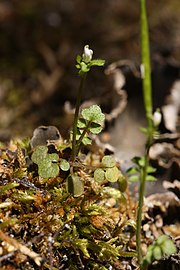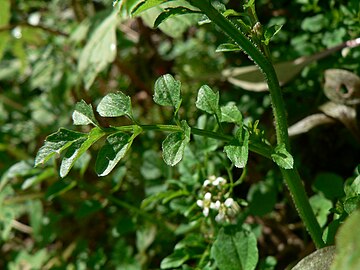Cardamine oligosperma
| Cardamine oligosperma | |
|---|---|

| |
| Scientific classification | |
| Kingdom: | Plantae |
| Clade: | Tracheophytes |
| Clade: | Angiosperms |
| Clade: | Eudicots |
| Clade: | Rosids |
| Order: | Brassicales |
| Family: | Brassicaceae |
| Genus: | Cardamine |
| Species: | C. oligosperma
|
| Binomial name | |
| Cardamine oligosperma | |
Cardamine oligosperma is a species of Cardamine known by the common name little western bittercress, native to western North America.
Description[edit]
C. oligosperma is an annual or biennial herb growing from a taproot. It produces one or more upright, branching stems 8–50 centimeters (3–18 inches).[2] The leaves are divided into many leaflets. The plant generally has a large basal rosette and smaller leaves further up the stem, each with 5–9 nearly round leaflets.[2] Most prominently blooming in early spring and early autumn,[2] the inflorescence is several centimeters long and bears many flowers with white petals just a few millimeters in length. The fruit is a silique (pod) up to 2.5 cm (1 in) long,[citation needed] containing 15–22 seeds.[2]
Taxonomy[edit]
Oligosperma is Greek for 'few seeds'. Common names include snapweed and shotweed for the plant's tendency to throw seeds when touched.[2]
Distribution and habitat[edit]
It is native to western North America from Alaska to California to Colorado, where it grows in moist mountain habitats.
Toxicity[edit]
The plant often throws its seeds when touched, which can cause irritation if they contact the eyes. Younger, more succulent plants are less likely to be carrying seeds.[2]
Uses[edit]
The leaves are edible raw and other tender parts of the plant can be cooked,[3] though have also been eaten raw.[2]
References[edit]
- ^ NatureServe (2023). "Cardamine oligosperma". Arlington, Virginia. Retrieved 30 November 2023.
- ^ a b c d e f g Benoliel, Doug (2011). Northwest Foraging: The Classic Guide to Edible Plants of the Pacific Northwest (Rev. and updated ed.). Seattle, WA: Skipstone. p. 41. ISBN 978-1-59485-366-1. OCLC 668195076.
- ^ Nyerges, Christopher (2017). Foraging Washington: Finding, Identifying, and Preparing Edible Wild Foods. Guilford, CT: Falcon Guides. ISBN 978-1-4930-2534-3. OCLC 965922681.
External links[edit]
- Jepson Manual Treatment - Cardamine oligosperma
- USDA Plants Profile; Cardamine oligosperma
- Cardamine oligosperma - Photo gallery



